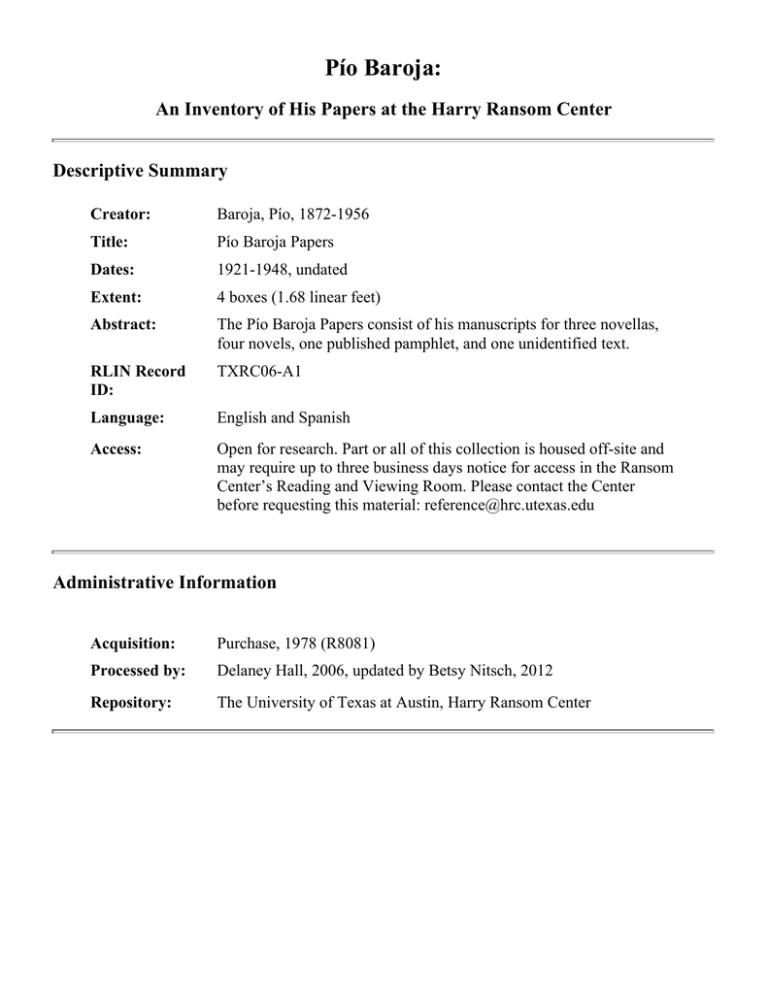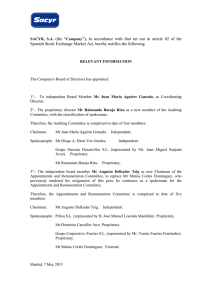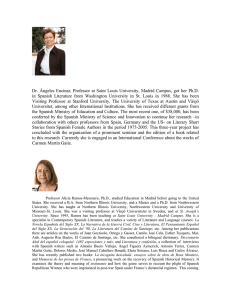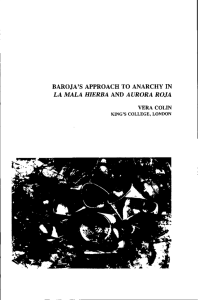Pío Baroja - Harry Ransom Center - The University of Texas at Austin
Anuncio

Pío Baroja: An Inventory of His Papers at the Harry Ransom Center Descriptive Summary Creator: Baroja, Pío, 1872-1956 Title: Pío Baroja Papers Dates: 1921-1948, undated Extent: 4 boxes (1.68 linear feet) Abstract: The Pío Baroja Papers consist of his manuscripts for three novellas, four novels, one published pamphlet, and one unidentified text. RLIN Record ID: TXRC06-A1 Language: English and Spanish Access: Open for research. Part or all of this collection is housed off-site and may require up to three business days notice for access in the Ransom Center’s Reading and Viewing Room. Please contact the Center before requesting this material: [email protected] Administrative Information Acquisition: Purchase, 1978 (R8081) Processed by: Delaney Hall, 2006, updated by Betsy Nitsch, 2012 Repository: The University of Texas at Austin, Harry Ransom Center Baroja, Pío, 1872-1956 Biographical Sketch Pío Baroja, considered one of the most prolific novelists of twentieth century Spanish literature, was born on December 28, 1872, to Serafin Baroja y Zarnoza and Carmen Nessi y Goni. Baroja had two brothers, Dario and Ricardo, and a sister, Carmen. The family eventually moved from San Sebastian, located on the northern Basque coast of Spain, to Madrid, where Baroja, at age fifteen, began to study medicine. He received his degree in 1893 after presenting his doctoral thesis on psycho-physical aspects of pain and moved to Cestona to work as a country doctor. He left the practice after only a year--tired, he said, of small-town life and the trivial rivalries of the profession--and moved back to Madrid to manage his aunt's bakery. In Madrid he began writing more seriously, contributing regularly to a journal called Revista Nueva. When the bakery failed in 1902, Baroja devoted himself full-time to writing, often publishing more than two books a year until his death in 1956. Baroja published Vidas sombrías( Dark Lives ), a collection of short stories, and La casa de Aizgorri( The House of Aizgorri ), his first novel, in 1900. La casa de Aizgorri, El mayorazgo de Labraz( The Lord of Labraz ), and Zalacaín el aventurero( Zalacaín the Adventurer) form Baroja's first trilogy, Tierra Vasca( Basque Country ), completed in 1909. Baroja clustered many of his novels into cycles and series, the largest being the twenty-two volume Memorias de un hombre de acción( Memories of a Man of Action ). Most consider El árbol de la ciencia (first published in 1900, and translated as The Tree of Knowledge in 1922) to be Baroja's greatest work. The semi-autobiographical bildungsroman details the life of Andres Hurtado, a young medical student who searches for meaning, confronts life's injustices, and ultimately commits suicide. Like many Spanish novelists, Baroja wrote in a pessimistic and picaresque style. Most critics agree that Baroja belonged to the Generation of 1898, a loosely linked group of young writers preoccupied with Spain's social and political deterioration at the turn of the century. Much of Baroja's writing--characterized by its simplicity, directness, and use of colloquial language--focuses on the difficulties of modern city life for the Spanish underclass. Although Baroja practiced medicine for only a short time, his medical experiences left deep and abiding impressions. Baroja scholars estimate that 200 physicians appear in his collected works. Baroja lived a fairly quiet and sedentary life in Spain, but would occasionally travel through Europe, especially to France, England, and Italy. During his travels he met other literary luminaries like Oscar Wilde and Spanish poet Antonio Machado, and he accumulated an impressive library of books about witchcraft and the occult. In July 1936, at the start of the Spanish Civil War, Baroja was imprisoned as "an enemy of tradition." Even though a member of the army recognized Baroja as a famous author and released him after a single night in jail, Baroja was outraged and moved to France. He didn't return until the end of the war in 1939. Back in Madrid, Baroja published his memoirs. The six volume Memorias( Memories) 2 Baroja, Pío, 1872-1956 Back in Madrid, Baroja published his memoirs. The six volume Memorias( Memories) appeared between 1944 and 1949. In his old age Baroja suffered from arteriosclerosis and memory loss. He died in Madrid on October 30, 1956, and family, friends, and writers attended his funeral. Ernest Hemingway, an admirer, was asked to be a pallbearer but declined, saying he felt unworthy of such an honor. Sources: Baroja, Pío Caro, ed. Guia de Pío Baroja: el mundo barojiano. Madrid: Caro Raggio: Catedra, 1987. Patt, Beatrice P. Pío Baroja. New York: Twayne Publishers, 1971. "Pío Baroja." Contemporary Authors Online, http://galenet.galegroup.com (accessed 20 February 2006). Scope and Contents The Pío Baroja Papers consist of his manuscripts for three novellas, four novels, one published pamphlet, and one unidentified text. The manuscripts date from 1921-1948 and are arranged alphabetically in a single series. All manuscripts are written in Spanish. The following titles are included: Los buscadores de tesoros( The Treasure Seekers ), La casa de los Rosales( The Rosales Family's House ), Los enigmáticos( The Enigmatic Ones ), El estanque verde( The Green Pool ), El cura de Monleón( The Priest of Monleón) from La juventud perdida( Lost Youth) trilogy, and El amor, el dandismo, y la intriga( Love, Dandyism, and Intrigue) and Las furias( The Furies ), both from Memorias de un hombre de acción( Memories of a Man of Action ). The unidentified typescript is twenty pages long and begins mid-sentence: "...a comer de las bellotas." The characters mentioned include Father Caballeria and Mosen Juan. Partway through the typescript a new chapter begins, entitled, "Un cura hechicero." The manuscripts are in good condition: legible and firmly bound. Six of the manuscripts are typed, with handwritten corrections in the margins. Two of the manuscripts are handwritten with typescript inserts. Most of the manuscripts are dedicated, in Baroja's hand, to "Dr. Manuel Val y Vera." Manuel Val y Vera was a longtime friend of Baroja's and the basis for the recurring character, "Dr. Valverde." Related Material Additional Pío Baroja materials are located at the Ransom Center in the Alfred A. Knopf Records and the Carlton Lake Collection. 3 Baroja, Pío, 1872-1956 Index Terms Subjects Authors, Spanish -- 20th century. 4 Baroja, Pío, 1872-1956 Series I. Novels and Novellas, 1921-1948, undated Los buscadores de tesoros (The Treasure Seekers, 1939) and published pamphlet of Container the same title, undated 1.1 La casa de los Rosales (The Rosales Family's House, undated) Container 1.2 Los enigmáticos (The Enigmatic Ones, 1948) Container 1.3 El estanque verde (The Green Pool, 1943) Container 1.4 La juventud perdida (Lost Youth), trilogy title El cura de Monleón (The Priest of Monleón, 1936) Container 2.1 Memorias de un hombre de acción (Memories of a Man of Action), series title El amor, el dandismo, y la intriga (Love, Dandyism, and Intrigue, 1922) Volume I Container 3.1 Volume II Container 3.2 Las furias (The Furies, 1921) Container 4.1 Unidentified typescript, undated Container 4.2 5 Baroja, Pío, 1872-1956 Barcode List 1--059188000055041 2--059188000055052 3--059188000055063 4--059188000055074 6







